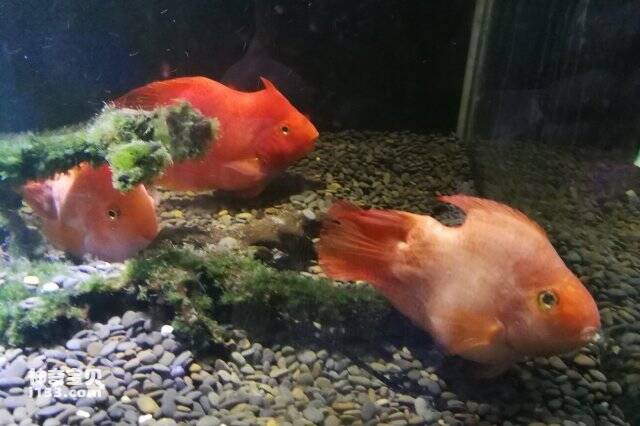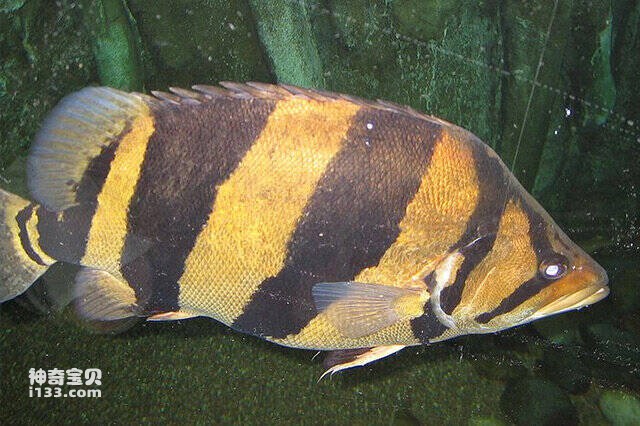What are the ten best large ornamental fish to keep in the world? There are many varieties of large ornamental fish on the market, no less than thousands. This article lists for you map fish, seven-star saury fish, Luohan fish, lucky fish, blood parrot fish, silver arowana, eel, flying anchovy, Thai tiger There are more than ten kinds of large ornamental fish that are easy to breed, such as fish. Let’s take a look with the editor below!
1. Map fish

The body of the map fish is covered with irregular red and orange markings, like a map, hence its name. Its body length can reach 30 centimeters under suitable natural conditions. Map fish are slow in movement and not ferocious in their habits. They are just extremely greedy and eat a huge amount of food. They eat almost any acceptable bait, but their favorite food is still fresh small fish and shrimps, so it is very easy to breed them artificially. , and they are strong and adaptable to almost any water environment. As long as the water temperature is controlled at around 26°C and sufficient food is provided, they will live very well and do not need special care. The only thing that needs attention is that they are really like pigs. They eat, sleep, and excrete a lot of feces. When raising them, you must choose a larger aquarium.
2. Seven-star saury

Seven-star saury, also known as Baokong humpback fish and flower saury, has a body length of 70-90 cm. The most eye-catching thing about the Seven-Star Knifefish is the seven black spots on its body, which are arranged in a regular manner and are very beautiful. Seven-star swordfish has a gentle temperament and does not have high requirements for water temperature, which is between 22-28°C. It grows very fast and likes to eat animal feed or live small fish and shrimps. The Seven-star saury is a nocturnal fish and you can choose to feed it at night. The Seven-star saury does not move too much during the day, so it is best to feed it at night. Fortunately, there are certain hiding places in the tank, which will enhance its adaptability to the environment.
3. Luohan fish

Luohan fish, also known as colorful snapper, has an adult body length of 20-40 cm, short height and back, beautiful patterns, bright and eye-catching colors, and rich color changes, and has high ornamental value. Luohan fish has a strong sense of territory and is quite domineering and good at fighting in mixed culture, so it is generally suitable to be raised alone. Luohan fish has a wide range of food habits. Both natural and artificial feeds can be used for feeding. It is generally fed with brine shrimp, shrimp meat, fish, blood worms, water earthworms, etc. In recent years, Luohan fish has set off a craze for breeding, and some people even regard it as a Feng Shui fish, which means seeking good luck and avoiding bad luck.
4. Lucky Fish

Lucky fish, also known as warship, has an adult body length of 20-69 cm. Lucky fish grows quickly and has loose requirements for water quality. The water temperature is 22-32°C and the water quality is neutral or slightly acidic soft water. The feeding of Lucky Fish needs to be well controlled. Firstly, the nutrition of the food must be ensured. The food must be fresh feed with high protein content, and rotten and nutritionally deficient food must not be fed. Secondly, a large amount of food must be ensured because Lucky Fish Fish have mixed food habits and a large food intake, so they are fed as needed every day. Lucky fish is suitable for living in tanks larger than 1 meter. Although there will be fights between males, it is suitable for mixed culture with most fish of similar size.
5. Blood Parrot Fish

The Blood Parrot Fish, also known as the God of Wealth Fish, is a type of parrot fish, with a body length of 15-20 cm, a bright red body, a chubby body and soft fins, which is very cute. The blood parrot is strong and strong and will eat almost anything, such as artificial bait, flakes, granules, red worms, brine shrimp, water lice, etc. It is like a trash can and accepts all comers. Because they have a wide range of food habits and are always eating, and they are extremely adaptable to water quality, it is easy to feed them without much care. Just change the water regularly, which is equivalent to stocking. If blood parrot fish are raised in groups, the scenery will be bright red and extremely spectacular.
6. Silver Arowana

Silver arowana, also known as the double-bearded bone fish, has a body length of 50-70 cm. The silver arowana is the gentlest and most fertile of all the bony tongue fish. When raising silver arowana, you must pay attention to changes in water quality, because diseases of silver arowana are generally caused by improper water quality and feeding. Maintaining good water quality is the foundation for raising silver arowana. Water quality problems are actually not difficult to solve. You need to pay attention to three points. First, keep the water pH value between 6.5 and 7.5; second, establish a good nitrification system; third, at the beginning of opening the tank, you need to go through trapped water, and every It is also best to change the water every time. As long as water quality management is completed, raising silver arowana is half the battle.
7. Gar

Adult gar can reach a maximum length of 3 meters. They are large ornamental fish that can eat, pull and be destructive. When feeding gar, you only need to keep the water temperature between 22-26°C, and the water quality requirements are not strict. Gars are carnivorous fish, such as small fish, shrimps, fish meat, water worms, etc. Gars can swallow fish that are 1/4 smaller than their body, and they do not chew, they just swallow them directly. Therefore, the digestive system of gar is extremely developed. Moreover, there is no need to change the water frequently when raising gar. An aquarist once changed the water only once every three months and added nitrifying bacteria during this period. However, the bottom of the tank was covered with feces, but the gar still lived well.
8. Flying Phoenix Fish

The phoenix fish is 30 centimeters long. It is a kind of ornamental fish that Chinese people and overseas Chinese like to keep. It is often mixed with arowana, tiger fish, deep-water turtles, etc. Flying anchovies are very easy to raise, as long as the water quality is the same as that used to raise arowana, tiger fish, and deep-water turtles. No special care is needed. They are omnivorous and like to eat garbage, remove oil films, and eat dragon poop, which arowana cannot eat. They also eat shrimp, meat, and phoenix, and can basically work part-time as a "senior cleaner" in the fish tank. Not only is it effortless to raise, it also helps with the hygiene of the fish tank.
9. Thai tiger fish

The body length of Thai tiger fish is 40 centimeters. When it reaches adulthood, it will form tiger-like patterns on its body. It has high ornamental value and is often used to entertain VIPs and watch. Thai tiger fish is a very strong fish species. Although it is called Thai tiger, its temperament is gentle and timid. It is easy to be mixed with other fish species. Thai tigers are suitable for weakly acidic to neutral soft water, as well as waters with a certain low salinity. During the breeding period, salt needs to be added. Since they like places with lush aquatic plants, rocks, and caves, and make caves their home, it is best to set up some bottomless flower pots to simulate caves, so that the Thai tiger fish will have a sense of belonging and become more obedient.
10. Crown Three Rooms

Crown Sanjian, also known as golden tiger, has a body length of 30-60 cm. It is not only a high-end edible fish species, but also a very famous ornamental fish. The conditions for raising Crown III are very simple, just keep the pH value at 5.5-6.5 and the temperature at 25-30°C. As a ferocious ornamental fish, you don’t have to worry too much about its food. Its powerful jaws and wide mouth help it subdue difficult prey. Therefore, if you want to mix fish in a fish tank, you must consider that the fish mixed with it should not be too small, otherwise they will be easily injured.
animal tags:
We created this article in conjunction with AI technology, then made sure it was fact-checked and edited by a Animals Top editor.